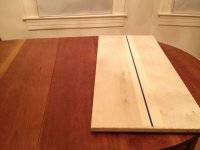On another thread, I suggested practicing shooting with your eyes closed in order to shoot better with your eyes opened. I didn't get any reply to that.
I just saw this
2 minute gun aiming video where the trainer demonstrates a similar thing when learning to find one's natural aim when using a handgun.
Can this technique be used for pool effectively, I wonder?
Jeff Livingston
No, because the standing shooting position used in the clip is for (I'm guessing speed shooting at steel plates) is nothing like the various shooting position one will use throughout the course of a match or lifetime of playing pool.
In the test thread, there are some shot setups you need to use in order to fully test the usefulness of any system or training aid you use.
Speed shooting at steel plates is for hitting somewhere in a area of a steel plate. Target shooting is about hitting the center of a bulls-eye and not just on the paper. Even though this is shooting, both use different technique and the goals are different.
I'm in a bewilderment about why there is this notion that shooting guns and pocketing balls in pool are alike. Maybe it is the use of common terms and phrases that has lead to this notion. Terms such as shot, pull the trigger, and aiming.
I have experience in another type of shooting. One that involves moving targets in various conditions and distances using both a rifle and handgun. This is nothing like shooting steels or target where the target doesn't move and the distance doesn't vary greatly.
In this type of shooting, you have to be ahead of the shot so to speak. You have to take the variables, target speed, distance, elevation into account to put the muzzle the needed amount ahead of the target. You have to see and feel the shot before you do the shot.
This same concept is in riding and racing motorcycles and going fast in cars. The faster you go the farther ahead you have to think about where you want to be on the track. How you enter one turn greatly affects the exit of that turn or a series of turns. If you have to block someone, you have to think ahead about where to do so before you do it. In racing, in your mind, your are always ahead of whats happening at the current time while still trying to be aware of whats happening around you.
When you get into shooting position and do a shot with your eyes closed, this is forcing you to think ahead about the shot. Now, you must see and feel the shot in your mind. No longer do have your eyes to let you see the shot, but you now have to visualize that shot in your mind without their influence.
You must see the shot in your mind first, then do it. Same concept applies with the eyes open. You must be ahead of the shot(see it in your mind), then do the shot.
